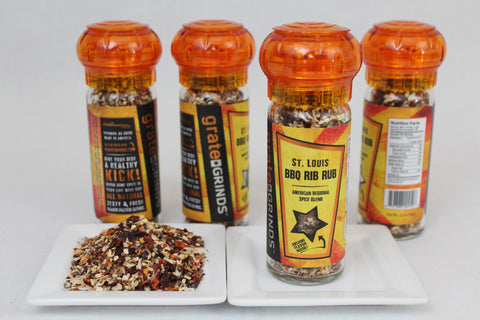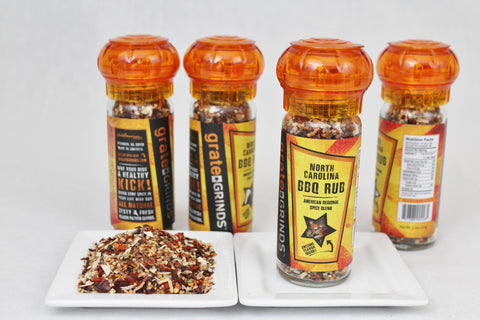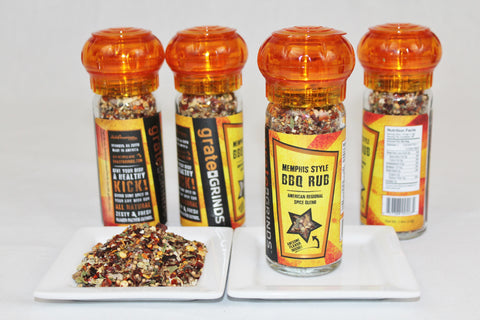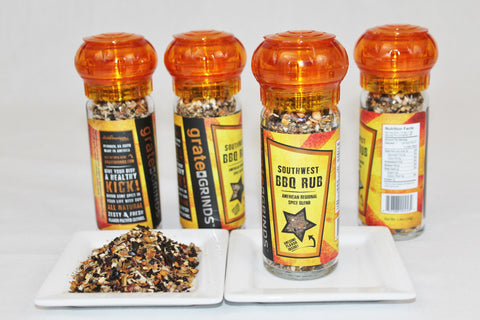Kansas City BBQ Rub
Kansas City BBQ Rub - Designed to characterize the essence of Kansas City, Missouri style of smoky, sweet and spicy barbecue with the use of Demerara sugar, New Mexican chile flakes and hickory smoked sea salt. This rub can be used on beef, pork, chicken, turkey, lamb and strong flavored grilling fish.
Share this Product
Kansas City BBQ Rub -Kansas City style barbecue started in the early 1900’s from Henry Perry in Kansas City, Missouri and is a slow wood smoked, pit cooked style of barbecue that is covered with the traditional sweet and spicy sauce that it is known for. Different from other American BBQ regions, Kansas City style barbecue uses various type of meat like beef, pork, chicken, turkey and sometimes fish. Our American Regional Kansas City BBQ Rub is the slow roasting compliment to the traditional sweet, spicy and tangy barbecue sauce. Grind this rub on your meat at least a few hours prior to roasting.
Spice Ingredients: New Mexican chile peppers, hickory smoked sea salt, garlic, black pepper, cumin, onion, sugar, clove and coriander. See the recipe section for cooking details. Happy barbecuing!
Kansas City BBQ Rub is available in a 4 oz. spice grinder bottle.
Please click on the RECIPE tab here for detailed cooking instructions.
Kansas City BBQ Rub Cooking Instructions
Kansas City style barbecue uses many styles of regional barbecuing and then adds that classic spicy sweet barbecue sauce to finish the flavor profile. Grind this rub on your beef, pork, chicken, turkey or full flavored fish for fun barbecue flavor experiences. It’s great on burgers too!
NOTE: If you would like to learn more about different types of foods to barbecue, grill or oven roast, please read the "Recommendations for selecting your Beef, Pork, Chicken, Turkey and Seafood" PDF, located in the RECIPE heading at the top of the Home Page.
1) To use the Grate Grinds Kansas City BBQ Rub, evenly spray or rub, a little oil on all sides of your Beef, Pork, Chicken, Turkey, Lamb or strong flavored fish like Salmon, Swordfish, Mahi Mahi or Red Snapper. Then grind the rub evenly on all sides of your meat, gently pressing it onto the surface. The amount of rub you grind on is up to your flavor preference. The more you grind on the more of a flavor impact the rub will have. Fig. 1 below is an example of how much rub to grind onto your meat, as a general rule.
NOTE: One word of caution, these rubs are self-contained, meaning that they already have salt in them in the proper ratio to the spices and herbs, so don’t overdo it with grinding the rubs and DON"T add any additional salt.

Fig. 1. Beef Ribs with Kansas City BBQ Rub.
2) If you use the beef ribs as in the ones pictured above, make sure that you remove the membrane from he back side of the ribs. It is tough and will not "melt" during the cooking process. Figure 2 & 3. below shows removing the membrane. Start at one corner and with the help of a paper towel or cloth, evenly and firmly pull the membrane back over it self. It isn't easy and if it tears keep trying. It will make for a better eating experience.

Fig. 2 Removing the beef ribs membrane from the back side of the ribs.

Fig. 3 Pulling the membrane off the back side of the beef ribs, firmly and evenly.
3) After you have rubbed your meat, refrigerate it and allow the rub to rest on the meat for at least 20 minutes or up to twenty-four hours. The longer the resting period, the more the rub can penetrate the meat.
NOTE: Always buy your meats from a quality reputable stores. Keep all meat under refrigeration as much as possible during preparation. Don’t leave any meats out at room temperature for more than 30 minutes, except when you are ready to cook it. Then let it just reach room temperature prior to cooking, but don’t let time exceed an hour. Food safe guidelines recommend that any proteins (meats in this case) are not exposed to the “Temperature Danger Zone” (40 F. to 140 F) for more than 4 hours for its entire journey to you cooking it. We are informing you of these food safety guidelines, because we want you to have a wonderful flavorful safe food experience, every time.
4) For cooking beef ribs, like pork they need the low and slow cooking method, since the meat it a little tough and needs that tender slow cooking to baste the meat with it's own fat and break down that tough meat to make it tender. This barbecuing method can be done in a smoker, barbecue grill or oven, technically. you will need to slow roast your ribs for 2 ½ to 3 ½ hours, depending on your oven or grill and amount of ribs being cooked.
SMOKER:
1) Preheat your smoker to 250-275° F. Place your seasoned beef ribs away from the direct heat source or smoke box. Rotate your ribs every hour to keep the smoking and temperature evenly around the ribs. Remember to resupply your smoking medium so the temperature remains constant throughout the cooking time. The cooking times can very from 2 to 4 hours. It really depends on the temperature and type of smoker you have and the amount of ribs you are smoking. (Final cooking instructions are below)
BARBECUE GRILL or OVEN:
1) Turn on all the gas valves or get all the coals hot and preheat your grill (oven) to 400° F to 450ºF. so the meat will sear rapidly sealing in the juices caused by this initial high heat process. Then turn off the gas burners on one side of the grill or move the coals to one side of the grill and place the pork ribs on the side with no gas or coals directly under the meat being cooked. This is called indirect cooking. Place your ribs on that side of the clean, oiled preheated grill. This searing process should take around 15 to 25 minutes, depending on the size and quantity of your ribs and the type and temperature of your grill. Your grill temperature should start to drop down and adjust it to around 275ºF to 300ºF. . Now your job is not to touch the meat or open the lid or door too often. Have a beer or soda, mow the lawn, watch a football game! The time it takes to barbecue your ribs depends completely on the temperature of oven, grill or smoker and the size and quantity of the ribs.
2) Don’t overcook them either. To barbecue your ribs properly, allow at least 2 ½ to 3 ½ hours. The key to the correct doneness of your slow cooked ribs is to get the internal temperature (with an instant read thermometer) of the meat up to 190ºF., but not more. You can get there in 2 hours if you push the temperature up, but the ribs will dry out, if you cook them too quickly. While cooking your ribs, occasionally check the temperature until they reach the 190ºF., which is the magic doneness temperature. The meat should have pulled back a little off the rib bones. It should not completely fall apart when you gently try to pick it up the entire rack, but if you pull off pieces of the beef they should come off easily. You should be able to cut in between the rib bones cleanly without the meat shredding, as shown below in Figure 5.

Fig. 4. Beef ribs barbecuing with smoking chips.
ALL COOKING METHODS:
Once you feel your ribs has reached the proper temperature, remove them from the grill or oven and let them "rest" under a foil tent. There is an activity that takes place now called “carryover cooking”. Once your food is removed from the heat source, it will continue to cook for 5 to 10 minutes for smaller cuts, 15 to 20 minutes for larger cuts of meat. The retained heat in the meat continues the cooking process for a few more minutes, as the meat cools down. Part of the resting period is to allow the internal liquids in the meat, which are forced to the center by the intense cooking heat, and it will take a few minutes for the liquids to redistribute themselves throughout the meat.

Figure 5. Sliced beef ribs with Kansas City BBQ Rub and grilled yellow squash. Happy eating! Use your favorite Kansas City BBQ sauce, if you wish.
For grilling quick cooking cuts of beef, lamb or pork and always tender crusts of chicken, turkey and seafood:
1) Preheat your grill or oven to 375 to 400ºF. Place your beef steak, pork, chicken, turkey or seafood on a 45º angle from the vertical grills on the preheated oiled clean grill (or in the oven in a roasting pan). When grilling, please try not to flip-flop the meat back and forth. Place your meat on the grill and let it cook, unmolested!!
2) After 3 to 4 minutes slightly rotate your meat 90º to get those classic grill mark lines on it. Leave it for another 3 to 4 minutes and then flip/turn it over. Avoid flare ups with a spray bottle of water. Now depending on the thickness of your meat and the temperature of your grill, it could take another 6 to 8 minutes to get your meat to the proper temperature.
3) Chicken and turkey should reach 165 F. Fish and pork should be cooked to 145 F. (USDA internal cooking temperatures for safe food)
4) If you are looking for a specific temperature of doneness according to your taste and personal preference use this BEEF general temperature guide: 125 F. for rare, 130 F. for medium rare, 135 F. for medium, 140 F. for medium well and over 150 F. for well done.
5) Once you feel your meat has reached the proper temperature, remove it from the grill or oven and let it "rest" under a foil tent. There is an activity that takes place now called “carryover cooking”. Once your food is removed from the heat source, it will continue to cook for 5 to 10 minutes for smaller cuts. The retained heat in the meat continues the cooking process for a few more minutes, as the meat cools down. Part of the resting period is to allow the internal liquids in the meat, which are forced to the center by the intense cooking heat, and it will take a few minutes for the liquids to redistribute themselves throughout the meat.
NOTE: For more detailed cooking instructions, please read the "Detailed Instruction for Barbecuing, Grilling and Oven Roasting" PDF located in the RECIPE heading at the top of the Home Page.
 PROUDLY MADE IN AMERICA
PROUDLY MADE IN AMERICA









